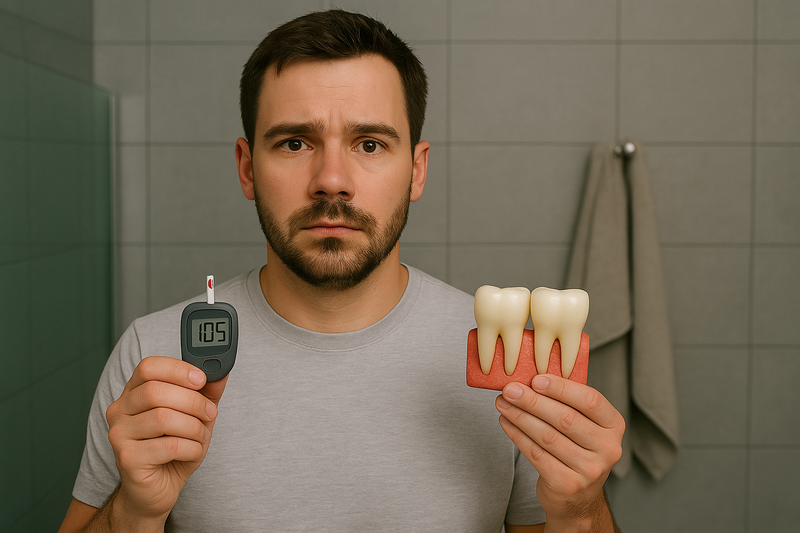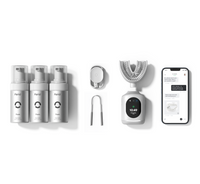
12 min read
Best Practices for Long-Term Gum Health and Disease Prevention
When we think about oral hygiene, most people immediately focus on their teeth. However, healthy gums are just as important for maintaining a beautiful smile and preventing serious dental issues. Gums provide essential support for your teeth, holding them firmly in place and protecting the roots from harmful bacteria. Without proper care, gum tissues can become inflamed or infected, resulting in discomfort, bleeding, and potentially leading to tooth loss over time. Prioritizing gum care not only helps your mouth stay in good shape but also contributes to your overall health.
Core Elements of an Effective Oral Care Routine
Brushing Twice a Day with Proper Technique
Maintaining long-term dental care begins with consistent brushing, which should be done at least twice daily. The way you brush is just as important as how often you do it. Using small, circular motions helps remove plaque from both the tooth surface and along the gumline. Avoid using harsh scrubbing movements, as this can damage delicate gum tissue and enamel. It’s essential to spend at least two minutes each time you brush, making sure to reach all areas of the mouth, including the back teeth, where plaque can easily build up.
The Role of Flossing and Antibacterial Mouthwash
The best oral care routine isn’t complete without daily flossing. While brushing removes plaque from the surface of your teeth, flossing reaches between the teeth where a toothbrush can’t. This helps clear out food particles and plaque trapped in tight spaces, preventing the buildup that leads to gum inflammation. In addition to flossing, rinsing with an antibacterial mouthwash can further support gum health by killing germs that brushing and flossing might miss. Mouthwash helps reduce bacteria along the gumline and freshens your breath at the same time.
Choosing Toothpaste and Tools for Gum Support
The type of toothpaste and dental tools you use can make a significant difference when focusing on how to prevent gum disease. Look for toothpaste that contains fluoride and ingredients specifically designed to fight plaque and gingivitis. These formulations help reduce inflammation and support the healing of sensitive gum areas. Pairing the right toothpaste with a soft-bristled or specialized toothbrush helps maximize the benefits. Always choose tools that feel comfortable and encourage you to maintain your brushing habits consistently.

Daily Habits That Promote Healthy Gums
Integrating certain daily practices can significantly enhance your gum health, providing substantial benefits that help prevent periodontal diseases and maintain overall oral hygiene. Here are small yet consistent habits:
- Stay Hydrated: Drinking adequate amounts of water daily significantly supports gum health by continuously flushing away harmful bacteria and food particles that contribute to gum disease. Water naturally neutralizes acids produced by bacteria in the mouth, reducing the likelihood of enamel erosion and subsequent gum irritation. Dehydration decreases saliva production, which usually serves as a protective barrier, balancing oral pH and helping repair minor tissue damage. Regular hydration is crucial for maintaining optimal saliva flow, which actively helps to clean and protect both gums and teeth. Water consumption after meals or snacks specifically helps remove leftover debris and minimize bacterial growth. Additionally, drinking fluoridated water strengthens teeth, indirectly benefiting gum tissue by creating a less hospitable environment for bacteria. When gums are continually hydrated, inflammation and the risk of periodontal disease are significantly diminished. To maintain sufficient hydration, aim for at least eight glasses of water daily and drink regularly throughout the day, particularly after consuming sugary or acidic foods.
- Eat Nutrient-Rich Foods: Foods high in vitamins C and D are particularly beneficial. Vitamin C-rich foods, such as oranges, strawberries, broccoli, and bell peppers, strengthen gum tissues by boosting collagen production, a critical protein for maintaining tissue elasticity and integrity. Vitamin C also exhibits anti-inflammatory properties, reducing gum swelling and redness commonly associated with gingivitis. Additionally, it supports the body’s natural immune response, enhancing your gums’ ability to combat bacterial infections. Vitamin D, found in fatty fish, fortified dairy products, eggs, and through sunlight exposure, aids in calcium absorption and utilization, thereby reinforcing bone density and tooth stability, which are foundational to healthy gum tissue. Vitamin D deficiency has been linked to increased susceptibility to periodontal diseases due to impaired bone and tissue repair mechanisms.
- Limit Sugar and Acids: Limiting the consumption of sugary and acidic foods significantly improves gum health by reducing plaque accumulation and preventing gum irritation. Sugary snacks and beverages feed oral bacteria, promoting rapid plaque formation, which eventually hardens into tartar along the gum line. Persistent plaque and tartar build-up lead to gum inflammation, known as gingivitis, and if unchecked, progress to more serious periodontal disease. Acidic beverages, such as soda, fruit juices, and energy drinks, can erode tooth enamel and irritate gum tissues, leading to sensitivity and inflammation. Consistent exposure to such acidic environments can significantly weaken gums, increasing susceptibility to bacterial infections.
- Chew Sugar-Free Gum: Saliva plays a critical role in oral hygiene by naturally washing away residual food particles and bacteria, reducing plaque formation and subsequent gum irritation. Saliva also neutralizes harmful acids produced by bacteria, maintaining an optimal pH level in your mouth. Sugar-free gums containing xylitol offer additional benefits, as this natural sweetener actively reduces harmful oral bacteria levels, decreasing the risk of gingivitis and tooth decay. The act of chewing itself strengthens gums and jaw muscles by stimulating blood flow, improving nutrient delivery, and waste removal at the tissue level. Regularly chewing sugar-free gum, particularly after snacks or meals when brushing your teeth isn't feasible, complements other oral hygiene practices effectively. It provides continuous protection and cleansing throughout the day, reinforcing the protective measures against gum disease.
Each practice complements and reinforces the others, creating an effective, holistic approach that maintains strong, resilient gums for lasting oral health.
Advanced Toothbrush Technologies for Gum Care
Sonic and Rechargeable Toothbrushes
Modern toothbrush designs have greatly improved the way we care for our gums. A sonic toothbrush delivers high-speed vibrations that help break up plaque along the teeth and gumline more effectively than manual brushing alone. These vibrations create gentle microbubbles that reach between teeth and under the gum edges, enhancing your cleaning routine. Many of these toothbrushes are rechargeable, offering the convenience of long battery life and consistent power. This ensures that each brushing session is thorough and reliable without losing performance. Advanced brushes are often designed with multiple cleaning modes, allowing you to adjust the intensity based on your needs.

Mouth-Shaped and U-Shaped Toothbrushes
For individuals with delicate gum tissue, using specialized brushes like a mouth-shaped toothbrush can provide a gentler yet effective cleaning experience. These designs are crafted to fit the contours of your teeth and gums, providing even coverage without requiring excessive pressure. Another option is u-shaped toothbrushes for adults, which are specifically designed to clean multiple surfaces at once with minimal effort. These toothbrushes are often recommended for individuals who struggle to maintain consistent brushing motions due to sensitivity or other challenges. The unique shape of these tools helps reduce irritation while still offering effective plaque removal.
Pressure Sensors to Prevent Overbrushing
Applying too much force while brushing can harm gum tissue and wear down enamel. Many of today’s toothbrush models now include pressure sensors that help maintain safe brushing habits. These sensors alert you when too much pressure is being applied, which helps protect sensitive areas from damage. By using a toothbrush for sensitive teeth with this feature, you can avoid unintentionally injuring your gums while still achieving a clean mouth. Some sensors provide visual cues through light signals, while others may pause the brush’s vibrations when excessive force is detected.
Timers and Pacing Features
Consistency is a key part of maintaining gum health, and many modern toothbrushes include built-in timers and pacing functions to support this goal. These features ensure that each area of your mouth receives proper attention by breaking your brushing time into segments. The timer encourages you to brush for the dentist-recommended two minutes, helping you stick to a routine that benefits your gums. The best toothbrush for plaque often includes a pacer that signals when it’s time to move to the next section of your mouth.
Leveraging Smart Dental Tools for Prevention
Real-Time Feedback and Brushing Guidance
Technology has made it easier than ever to maintain good oral hygiene habits through real-time brushing feedback. Advanced dental care tools now feature sensors that monitor your brushing technique and provide immediate feedback on any adjustments needed. These tools can detect whether you’re covering all tooth surfaces and applying the correct pressure, helping to prevent accidental damage to your gums. Instant feedback helps reinforce good habits and ensures that you’re not missing any critical areas.
App Integration for Habit Tracking
One of the most helpful advancements in next-gen oral care is the ability to connect your toothbrush to mobile apps. These apps track your brushing patterns and provide detailed reports on your progress over time. This feature helps you stay accountable by highlighting areas you tend to overlook and assessing the consistency of your habits. Many of these apps also offer helpful reminders to encourage regular brushing and flossing. Some systems even reward users for completing daily care routines, making the process feel engaging and motivating.
Customizing Brushing Modes
Everyone’s dental care needs are different, especially when it comes to gum health. Many advanced toothbrushes offer multiple brushing modes, allowing you to adjust the intensity to suit sensitive areas. These customizable settings ensure that your brush operates at a level that is safe and comfortable for your gums. This feature is handy for those prone to gum discomfort or inflammation. You can select a gentle cleaning mode specifically designed to care for sensitive gum tissue without compromising cleaning effectiveness. Integrating this level of personalization into your daily routine supports gum disease prevention by reducing irritation while still removing harmful plaque.
Professional Support and Preventative Lifestyle Choices
The Importance of Regular Dental Checkups
Maintaining healthy gums requires more than diligent home care practices. Regular dental checkups form an essential cornerstone of effective gum care, significantly enhancing your overall oral health. Below are key benefits:
- Early Detection of Gum Issues: Regular dental visits facilitate the timely identification of early-stage gum diseases, such as gingivitis, before they progress into severe periodontal problems. During routine checkups, dentists carefully inspect the gums for subtle indicators of inflammation, swelling, bleeding, or tissue recession—signs that are often overlooked at home. They may use specialized diagnostic tools or measurements to assess gum pocket depths, a crucial factor in diagnosing the progression of gum disease. By identifying these issues early, simple interventions such as deep cleaning or enhanced oral hygiene practices can effectively reverse initial damage and prevent the need for extensive treatment later.
- Professional Plaque and Tartar Removal: Despite diligent brushing and flossing, plaque accumulation is inevitable, particularly in hard-to-reach areas such as between teeth, beneath the gum lines, and around dental restorations. Over time, plaque hardens into tartar, a calcified deposit that can't be removed through ordinary home care routines alone. Regular professional cleanings performed during dental checkups utilize specialized instruments, such as ultrasonic scalers and manual curettes, to expertly remove stubborn tartar deposits without harming the gums or teeth. This thorough cleaning significantly reduces bacterial populations responsible for gum inflammation, infection, and the progression of periodontal disease. The removal of plaque and tartar not only prevents gingival irritation but also dramatically improves gum health by maintaining an optimal oral environment that discourages bacterial growth.
- Personalized Care Recommendations: Dentists analyze your oral health status, lifestyle factors, dietary habits, and individual susceptibility to gum problems, offering customized recommendations that precisely match your needs. They can suggest optimal oral hygiene products that best address your unique gum condition. Additionally, dentists can demonstrate proper techniques adapted to your oral anatomy, enabling more effective daily oral hygiene practices.
- Peace of Mind: Knowing your oral condition is consistently evaluated by a dental professional significantly alleviates these concerns. Regular reassurance that your gums and overall oral health remain in good condition enhances your confidence, reducing unnecessary worry and promoting greater emotional comfort. Conversely, if issues do arise, knowing they will be promptly identified and addressed provides further reassurance, eliminating fears about undiscovered or worsening conditions.
Incorporating regular dental visits into your healthcare routine provides invaluable long-term benefits that extend well beyond routine cleaning and basic evaluations.
Avoiding Tobacco and Irritants to Gum Tissue
Lifestyle choices have a direct impact on the health of your gums. Using tobacco products— Tobacco weakens your immune system, making it harder for your body to fight off infections that affect your gums. Even exposure to secondhand smoke can have harmful effects on your oral health. In addition to tobacco, it’s important to avoid irritants such as excessive alcohol consumption and highly acidic foods or beverages. Such substances can inflame and damage the delicate tissues in your mouth. Making conscious choices to stay away from these irritants supports gum health tips and promotes better healing and protection for your gums over time.

Utilizing smart dental monitoring systems allows you to stay informed about your progress and make adjustments as needed. Preventive care not only safeguards your smile but also reduces the likelihood of requiring more invasive treatments later in life. Focusing on prevention makes your daily efforts more meaningful and ensures that the health of your gums remains a priority. Staying committed to this path promotes strong, healthy gums that will continue to support your overall well-being for years to come.
Share




